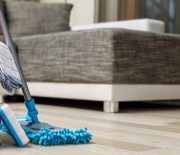Last update: 2 years ago

Think about this article as a cleaning product intervention. Our goal is to help you preserve your health and prevent you from committing one of those five cleaning product sins by mixing the wrong cleaning chemicals.
We’re glad to hear that you’re interested in cleaning your home and making your own cleaning solutions.
However, you need to know that there are some cleaning products that you should never mix, as they can be dangerous to you and your family’s health.
Bleach and vinegar
Can you mix bleach and vinegar?
Short answer: No.
Mixing bleach and vinegar creates chlorine gas, which can cause severe damage to your skin, eyes, and your throat and your lungs when inhaled. And by “damage”, we mean third-degree burns. Messing around with chlorine and mixing it with anything is not recommended.
Mixing diluted hydrochloric acid and chlorine creates a dangerous gas.
What to do instead?
When you buy a bottle of bleach, you need to remember that it has a shelf life. Its effectiveness will start to decrease after the sixth month.
Instead of trying to make it stronger by adding vinegar, you better go to the store and buy a new bottle. After all, what is one extra walk to the store compared to inhaling poisonous fumes?
Bleach and ammonia
Chlorine gas or maybe not?
Many people think that mixing bleach and ammonia will make chlorine. However, this is false. Combining them does not create yellow chlorine formation. What it does produce is nitrogen gas, which is even more dangerous.
They also produce many toxic products such as traces of hydrazine, chloramine, dichloramine and nitrogen trichloride. Even though you’re not creating chlorine gas, mixing bleach and ammonia can produce many unhealthy byproducts.
What to do instead?
Here you have two options. The first one is to buy other cleaning products, which are non-toxic, such as laundry detergents or bathroom and floor cleaners.
Your second option is to use white distilled vinegar or baking soda. Vinegar will kill mould and mildew, and baking soda can be a good solution, especially when mixed with a mild soap. Although these suggestions might not be as practical, cleaning experts confirm they are much safer and eco-friendly.
Chlorine and ammonia
Chlorine bomb
An interesting fact here is that chlorine will react with ammonia in two different ways. Chlorine will react with an excess of ammonia, forming nitrogen and ammonium chloride. Still, when a lot of chlorine is treated with ammonia, it creates nitrogen trichloride, which is a very powerful explosive.
What to do instead?
The solutions here are the same as for mixing bleach and ammonia. It’s crucial to never mix chlorine and ammonia, except if you’re a chemistry expert. Even if you don’t produce an explosion, there are other dangerous chemicals that you might create.
Acetone and bleach
Chloroform
Mixing acetone and bleach can be extremely dangerous. As you may have already guessed, mixing bleach with anything is not a good idea.
When we talk about mixing it with acetone, we talk about one of the oldest organic reactions known to produce the chemical chloroform, which can knock you out in minutes. It is highly toxic and can also cause organ damage.
If you don’t produce real chloroform, as this depends on the specific type and quantity of bleach and acetone you’re using, you can still form other toxic chemicals, such as phosgene.
What to do instead?
There are three alternatives:
- Instead of using acetone, use water. Make a solution of bleach and water. One part bleach to three parts water works best.
- Use a household detergent, such as Domestos bleach spray.
- Use only bleach. It’s stronger than the previous two. However, make sure you’re working in a properly ventilated area, as inhaling it for a long period of time can be dangerous, too.
Vinegar and hydrogen peroxide
Peracetic acid
These two ingredients are commonly known as natural cleaning solutions. You can use them separately on the same surface but don’t mix them in the same container. You will create something called peracetic acid. The health risks aren’t well-known, but in high enough concentration, peracetic acid is very corrosive and can cause a lot of irritation to your skin, eyes, nose, throat and lungs.
What to do instead?
You can make your kitchen a cleaner, safer place and fight bacteria without exposing your family and yourself to toxic chemicals that also damage the environment. Use a simple, safe disinfectant spray. As a bonus, it is inexpensive. Another option is to use the vinegar and the hydrogen peroxide, as already mentioned, on the same surface but separately.
Takeaways
Don’t try to play home chemist. Actually, don’t mix cleaning products together. Period.
Instead, use the cleaners that have already been pre-mixed for you and read our blog for more ideas. Entrust your home chores to an experienced professional cleaner who can provide the desired results without unnecessary risk.
Do you need a helping hand?
Hire a professional cleaning team!








